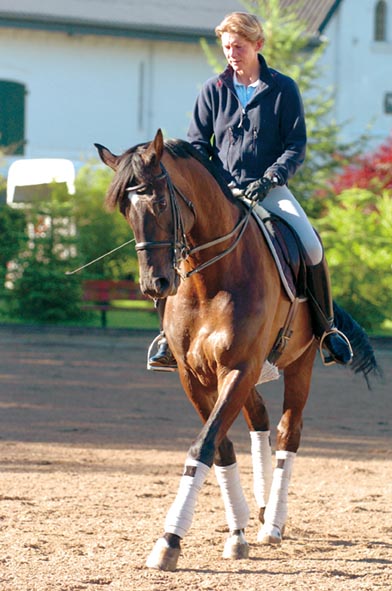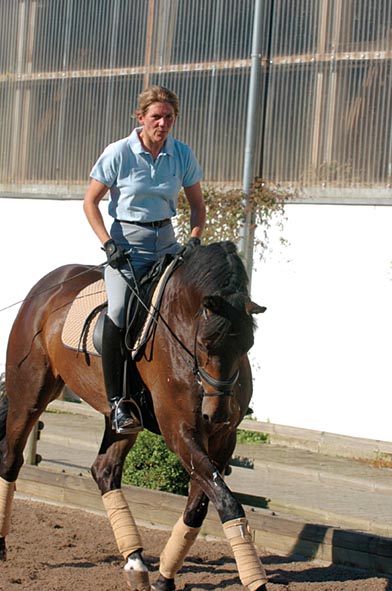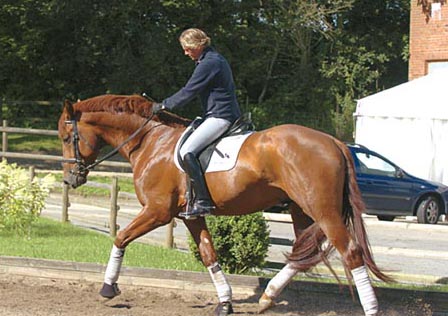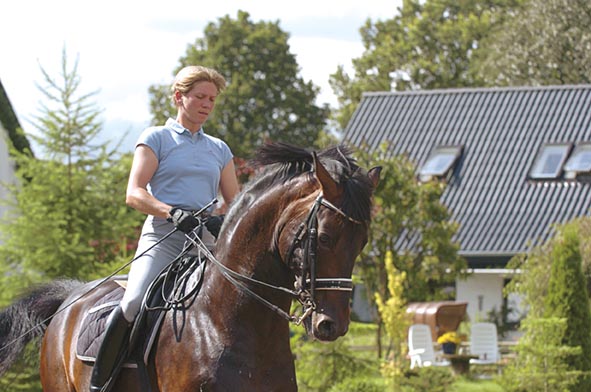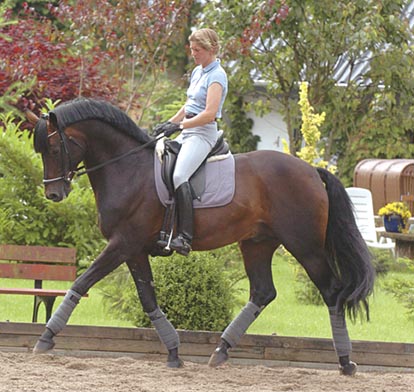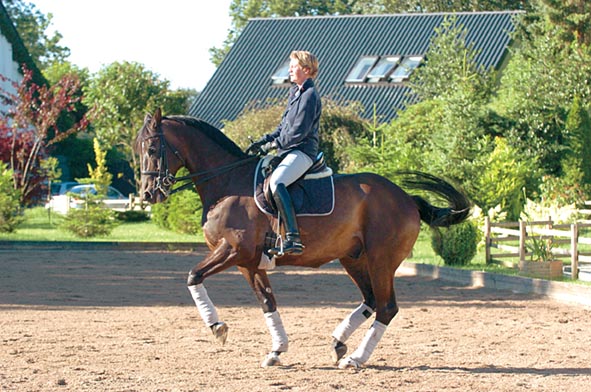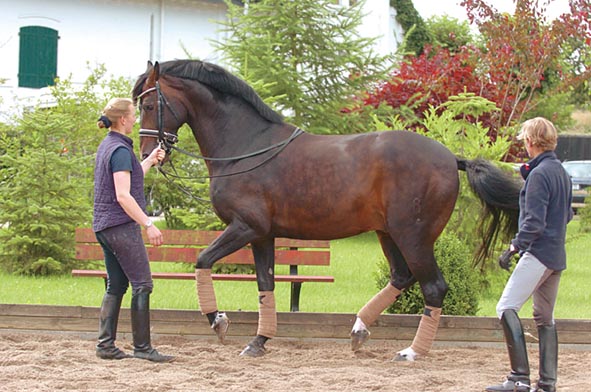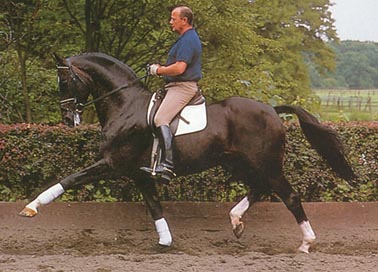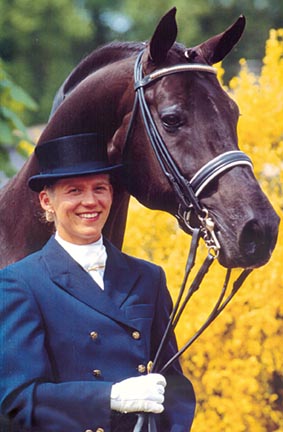Once again we are joining German dressage star, Martina Hannöver at her home, for a normal working morning, but before Martina starts working the next horse, it is time for a coffee and a discussion of the Warm up principles…
Watching you warm up, it is very nice what you can do in walk when you have just taken the horse into the arena, bending the horse, doing half passes, shoulder in… It doesn’t mean that you have to waste this time warming in, just walking around on a loose rein?
“In walk you can start making gymnastics with the horses, especially if you have one like the Trakehner which is a bit stiff in the knees and the back, he is so short, it helps him to do shoulder in, traver, renvers, half pass in walk, just asking for the bending and listening to your leg, and giving in the ribs.”
And they are taking the contact on the outside rein?
“Sure you can’t do it without the outside rein, that is the most important thing is to make them listen to the outside rein – it goes without saying that you keep the outside rein.”
“Warm up varies with the horse. My friend, Michi is going to ride her young horse, Funny, and she likes to start with shoulder in, and bending and everything like she does with Inara, who is her Grand Prix mare. But I told her, she is not allowed to start the work with the young one like this, because it will just make him tense, because walk is a movement without a moment of suspension – and everyone who has ridden a motor bike and has done an exercise of riding serpentines very slowly, knows how difficult it is to go so slow. And this young horse is the same, he does not have the balance to do this like the older horse had. He does not have the muscles, the balance, with him it would just make him tense and take away everything we’ve been working on – making him loose and going forward and relaxed.”
It is time for Martina to stop talking and start riding. As always it is an enlightening working session, a demonstration of ‘unblocking’ – working with the two four year olds, Funny (by Florestan) and Remember Me, full brother to her grey Rescue Me, by Rubinstein.
With the Florestan gelding, Martina is actually asking for some more extreme flexions, to the inside, and counter bend:
“Funny is falling out over the outside shoulder, so the whole horse is not straight and you can’t control him with half halts on the outside rein – which actually should be the way to correct him. But he didn’t accept it, so I just tried to make him straight with bending, also to the outside sometimes, making him unblock in the poll.”
“The poll is the important thing. The wrong thing is to over bend and just pull. For sure, sometimes you must pull more on the inside rein to make him give, and bend the neck. But we are going back to the basics again and again, and the basic is that you must have your horse straight, out of a straight horse you can ask for honest bending. The same in the poll, the neck and in the rib.”
Martina is also testing the self-carriage of Remember Me, giving away the rein, what the Germans call uberstreichen, this is an important test in their young horse classes.
In the Young Horse test when it says ‘uberstreichen’ should the horse change its frame?
“No the horse should stay where it is, and show self-carriage.”
How do you train a horse to stay in self-carriage?
“You can feel that the horse is ready to do this when the horse is really giving in, and is soft in the hand – when you have the horse really through.”
How long should you hold the position?
“In the test, most of the time it is in canter, and I always do three canter jumps. Actually if the horse is through and relaxed you can maintain it for a long time. You have to have the horse on your seat, not holding it with your hands.”
How do you get young horses – 4 and 5 years old, listening to your seat, and off your hands?
“You have to ride… Transitions in trot and in canter, to make the horses listen, and go in front of your leg, and come back with many little half halts, not one strong one. When the horse is listening, then out of my upper body I can also make some changes in the movements, when I am strong with my upper body – not tense but strong – and ride out of my tummy, I can make the horse bigger, more up hill.”
To slow them down?
“Get a little weaker, and with little half halts.”
Now it’s time for Martina to work with the top of the scale, her Grand Prix stallions, Donner Bube and Ratino. As his name suggests Donner Bube is by Donnerhall out of a Pik Bube, while Ratino is by Rubinstein and out of a Holsteiner mare by the Thoroughbred, Schampus.
Donner Bube is a bigger, heavier sort of horse, he just looks like a very relaxed and casual sort of individual, and he requires a very individual approach:
“With this horse I can make him sharp, but right now, for his body he needs to warm up and come loose through his back, so that every part of the horse is swinging, not just get on and say, piaffe, because he a Grand Prix horse.”
What were you working on with him?
“Waking him up because he has two days of vacation. And then to get him through, and just listen to me. It’s only Tuesday, and the competition is at the weekend, so he doesn’t have to be super today. I didn’t want to do everything today, I just wanted to make him listen to me, and working with the exercises from the Grand Prix, playing around but not really going through a Grand Prix test.”
And with Ratino?
“Nearly the same. Woke him up a little, rode him loose, I told him in the flying changes on the diagonal that I want more respect, not his hind end coming up in the air. I did that with a change through walk, also on the diagonal and then went back to four tempis, or just two flying changes – so they are not excited about doing two tempis, one tempis.”
At what age do you start playing around with piaffe and passage?
“Ratino was offering piaffe very early, like when he was four or five. If they give it to you, then you take it without losing the control of the basics. You must watch out that they don’t get tense when they give it to you, and you must always be able to come out of it easily. You have to remember that later on you have to teach them for the Prix St Georges and higher tests where we also need the collected walk and the extended walk, not just piaffe.”
Now Martina discusses another horse in relation to piaffe, the rather spooky brown Trakehner who we discussed earlier in warm-up, who has only recently come to her for training. He has a spectacular piaffe, but then finds it hard to master the transition in and out of piaffe….
“They must have the talent to do piaffe. Some horses, like this Trakehner, are taught to do it with a lot of pressure, he got afraid of himself especially when he got one or two steps of good piaffe, then he gets tense, and that is why we can’t get the transition from piaffe to passage. He can do piaffe, he can do passage, but with both together he still gets tense, that is why I am trying with half steps forwards, always in front of my leg, because he is sitting down so much on the hind leg that it is very hard for him to trot out of it.”
I think people misunderstand you when you say, ‘if a horse offers me piaffe at four years old’, then they will say, ‘see they teach piaffe to ALL the four year olds in Germany…’
“This is a dangerous thing, people can always misunderstand what you say. If a talented horse at four or five years is doing some half steps, it means half steps, it doesn’t mean piaffe. You can do so much damage by asking too much, just a little centimetre and you have stepped over the point. These are the kind of horses they have the talent, and it is very close together – genius, and becoming crazy.”
Is that a problem with the horses that are forced to do piaffe too early and for too long, then you get horses that don’t want to go on the centre line in the Grand Prix test, because they know the piaffe / passage is coming?
“I watched the tests at Aachen, and some of the better horses on the last centre line were too excited. I don’t know why this happens, because, knock on wood, I have never had one that I trained myself that reacts like this. I don’t know where the point is but I think it is too much pressure. The horses know the test. Some people say they are not intelligent, but they are. I can remember with Rubinstein when learnt the test, he really came in front of me. It is the same now with the passage and then the canter, there are so many horses that you can see get in front of the rider – they know the test, they know the way. You have to be careful all the time to make sure that they listen to you.”
Martina is also working a little in hand – this time with Donner Bube.
Who taught you how to do work in hand?
“Who? Nobody! You start to talk with other people about it. I talked with Karin Rehbein, and she said she does it sometimes with Kristy (Oatley-Nist) on top, and I remembered we did this a lot with Mr Rehbein – someone was on the horse and he was on the ground. Maybe I don’t have the right rider, or maybe the horses are a little bit weaker, younger but I tried it without a rider and it works.”
“It is very difficult and I always said ‘I can’t do it’ but then the girls said, ‘oh you are doing it much better than this or that person’ – that makes me think, I am getting better.”
Last month we discovered that fourteen-year-old Martina Hannöver had graduated from ponies to horses, and is starting to get serious about riding… I wanted to become a jumping rider. I had ridden in three day events, and I decided a I wanted to be a jumping rider. But first my mother said I had to learn a normal job that was when I came out of school at the age of 17. So I worked in a shop that sold food, and I had very good reports. When I was 18 I was invited to Stallbolmoor to apply for a job, I got it, so I quit the other job and told my mother and she said ‘oh oh oh…’ This place was already being run by Jorn (now Martina’s husband, Jorn Sternberg) and his parents. Jorn was a jumping rider at that time and Mr Scheirloh was the riding teacher. He was a super person, very good with us, with the horses, with the clients, with the property. He was riding both dressage and jumping, at that time it was very important if you wanted to become a bereiter, to ride both. But I wasn’t allowed to do three day eventing any more, Jorn’s parents said it was too dangerous, if you want this job, this you have to stop. Were you a good jumping rider? No, I was blind. Maybe they should have noticed earlier that I need glasses. But I got the horses very clean for Jorn because they learnt to jump out of pretty nearly every situation because I put them wrong all the time. That was Jorn’s most successful time competing! And the horses were well ridden in dressage, all of them made a good collected canter, good turns, if he qualified for the jump off, they went well. I spent nearly five years there. The last year I started to ride more dressage. I got one Swedish stallion – Sponseo – from Jorn’s sister because she didn’t want to ride him any more, and Mr Scheirloh was a little heavy for him. On him I did my first L test, my first M test I won with him. After I got my Bereitership, I tried to get a job at Gronwohldhof but there was no place for me. I kept on trying, then in December, Mr Rehbein rang and said, okay you can have the job and it starts on April 1st! Was it hard? It was unbelievably hard, I was more used to short stirrups – I’d had just one dressage horse that I rode, but I mainly rode the jumping horses for Jorn, and rode them in the jumping saddle with short stirrups. I remember the first day at Gronwohldhof, I had to warm the horses up for Mr Rehbein, I rode Charmeur and Mystique, both of them big, with a lot of big trot, and a lot of schwung. When I started to trot, I had big problems to do rising trot, but then when I had to go into sitting trot I felt that I would land on the roof, every single step, I couldn’t sit on these horses. I thought he was going to throw me out on the first day! But he didn’t do this, he just sent me for a few weeks in the small hall to learn to sit. It was a very hard – we all started at six o’clock. Even the riding teacher, Reinhard Neilson, we all did the stables, then we had breakfast and started to ride. After a while I got the very good job, I was the one warming up the horses for Mr Rehbein, and I got to go to competitions with him. I started at quarter to six with the first horse, warm him up, then Mr Rehbein came. That is how I learnt most of what I know now, because I got the good horses to ride. I’d just warm them up, sometimes he’d say, do an extended trot, do this, do that. Later on, he would let me do a little bit of piaffe, and he was always telling me you have to get the real feeling on the better horses. If you don’t feel it you can’t teach it – not to the horse and not to the rider. He was a super teacher. He didn’t say so much, if you ‘stole’ with your eyes, you could watch him when he taught other people, but the main thing was when you got back on the horse after he had ridden it, and you felt that it was one metre shorter, it was always an amazing experience. Was Mr Rehbein a very theoretical man? Not at all, he just threw some words into the arena at the right moment, and when you did what he said, it worked. I can’t remember him telling me the theory of why I should do something – always just do it. No tricks at all. There was a system, and a basic, and you followed it. At that time there were some very good riders at Gronwohldhof? The best in the world. The whole Swedish team were there all the time. The Americans were there, the Finns, the English. It was very busy; when you came in the entrance hall of the arena it was always full of the big tack lockers of the overseas riders. And lots of people in the hall – 14/15 at a time… We were allowed to ride our horses only in the afternoon because he was so busy with his clients in the morning. I spent four and a half years with Mr Rehbein, I did my riding teacher exam. I rode a lot of five and six year old horses in the Bundeschampionate. After I passed my riding teacher exams, I married Ralf Hannöver, and we left Schleswig-Holstein, and went to Oldenburg. He was also at Gronwohldhof, but his father wanted him to come back as the oldest son, and run his stable, but the father was too young to give it away, so it didn’t work, and we ended up at the famous Gestüt Vorwerk – and that’s how I met Rubinstein. |



